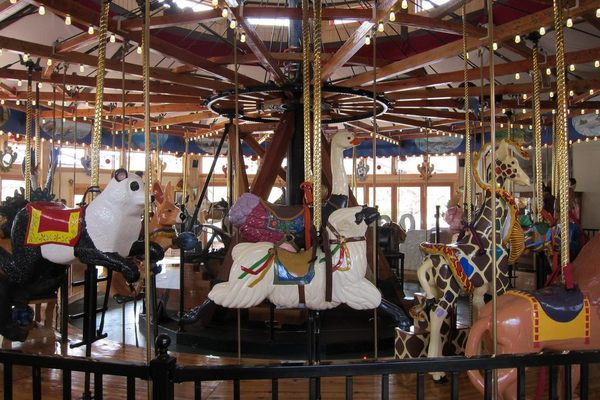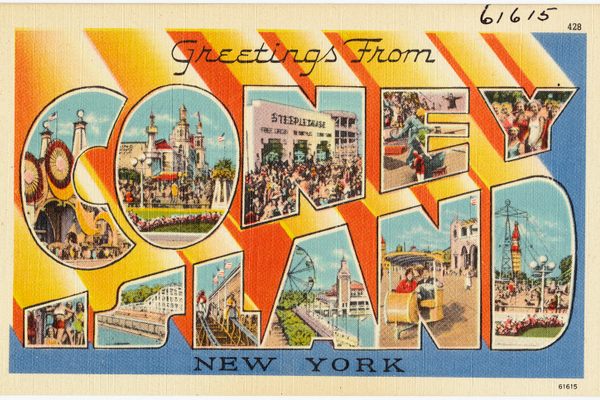
How a Self-Trained Italian Blacksmith Built Himself an Amusement Park
Bruno Ferrin made a wonder in the woods by hand and by chance.
When, in 1968, Bruno Ferrin first set foot in the poplar forest on a hill near Treviso, Italy, he knew he had found a good spot. “I was looking for a way to work in my spare time,” he says. “And thought I could open a casual food stand in the woods.” Fifty-three years later, that patch of woods on Montello hill is home to something a fair bit larger and more unexpected.
At first, Osteria Ai Pioppi (Tavern at the Poplars), located off a country road along the Piave river, looks like many other low-key rural restaurants in the area. At large wooden tables, customers can order traditional dishes from the Veneto region: cod with polenta, sausage, grilled cheese. And next to the parking lot is another sight that’s not unusual: a playground with a slide and two swings. But a short walk into the woods and things get odder. “This is a centrifuge,” Ferrin says as he walks toward a 12-foot-tall cylindrical structure made of colorful steel tubes surrounded by four pedaling stations. “It’s powered entirely by those bikes.” This ride, like all the 37 attractions in Ferrin’s amusement park, operates on human effort and the laws of physics. In this case, the power generated by pedalers can rotate the cylinder at a high enough speed to pin people inside to the wall. “To make it work you need four friends pedaling hard!” Ferrin explains.
Ferrin’s amusement park feels like a cross between an abandoned theme park frozen in time and a gigantic outsider art installation. First, there is no cacophony of buzzing motors, carousel tunes, and delighted screams, only an an eerie silence punctuated by the chirping of birds. Vegetation sometimes seems to merge with the rides, such as the gnarly branches of wisteria that envelope the supporting structure of a slide. Sunlight filtering in from the poplar canopy adds to the otherworldly vibe. Ferrin, wearing a blue smock with a matching hat, and holding a carved poplar branch as a walking stick, looks, honestly, like a wizard in a children’s book.

Unsurprisingly, Ai Pioppi, once it was discovered by social media, became an Instagram and TikTok sensation, often framed it as a “green amusement park.” But Ferrin doesn’t have designs on viral fame or environmental innovation. This is just the manifestation of his calling.
Ferrin was born in 1937 in Treviso, a town in Veneto around 17 miles north of Venice. He grew up in the old rituals of pre-industrial rural life. People worked the fields every day except Sunday. “Everything was manual back then,” he says. “Farmers would harvest wheat with a sickle and fields were plowed with oxcarts.” Children were accustomed to turning used tools, old bike tires, and broken rakes into toys. “All we needed to have fun was our own imagination,” he says with a hint of nostalgia.
Today, Ferrin’s favorite time is what he still spends in his workshop, working old steel tubes gathered from local blacksmiths into more pieces for his amusement park. “Young people praise me for being sustainable because I reuse old materials,” he says, “but that’s all I’ve ever known to do!”

A mostly self-trained blacksmith, Ferrin finished compulsory schooling at age 10 and took on various jobs as a farmhand. In his early 30s, he worked as a flour salesman. He started work at 4 a.m. and finished at noon, when bakers had also finished their shifts. So he looked for part-time work. He and his wife, Marisa, started a food and wine stand in that patch of Montello hill.
A few months into their new venture, the swing came first, to attract families. Ferrin installed the four poles, but was missing two hooks. The response he got at a local blacksmith shop changed his life. “The blacksmith told me he had no time for such a small job,” he says. “He pointed to a welding machine and said I could try to make one myself.” Ferrin spent the next three hours making a hook. He went back to his wife with red eyes and some low-grade burns—and two hooks for the swing. “I fell in love with it,” he says, “that feeling of having created something from a piece of metal.”
Soon a newly installed slide proved very popular. Then rocking horses. “I started to realize that people were coming for the rides more than the food,” he says. Encouraged by the success, he spent some time refining his wielding technique with professional blacksmiths, but it was never part of a grand plan. “It just kind of happened,” he says. “I would make one ride and then another, and another.” Today, Ai Pioppi covers some 65,000 square feet.

Now, every day, Ferrin spends several hours in his workshop, welding, drilling, and painting. But no day is like another. “What I love about my life is that I am truly free,” he says. “I work on what I want when I want.” It can take a few weeks or months to make a ride. Or longer. He might start working on a piece, gets wrapped up in other things such as maintenance or cooking. “I don’t have a watch or a phone,” he says with a smile. “I get a sense of the time from the changing sunlight.”
During the winter, which can be harsh in this part of northern Italy, the osteria is closed. Ferrin spends his time in his workshop and with his family. By late March, things are back in operation, but only during weekends. August is the only month in which the osteria and park are open every day. On Sundays, lines for lunch at the osteria, which can seat 1,500, can take up to two hours. “That’s a great satisfaction for me and my family,” Ferrin says, “this place is not in a trafficked street so people need to come on purpose.”
And the popularity of the osteria allows Ferrin to keep the amusement park free. “This is my personal philosophy,” he says. “If, at the end of the year, we see that we have made enough with the restaurant, then that’s good for us.” Over the past 50 years friends have suggested the introduction of a fee, even a symbolic charge of a euro or two. He resists. “Today everything seems to have a price,” he says. “I want people to come here, have a bite, enjoy the fresh air and play.”

In a way, Ferrin seems to have recreated the creative play of his childhood in pre-industrial Italy. Some of his rides are inspired by real-life applications of physics he had witnessed as a kid. “The local priest used to ask us children to help play the church bells,” he says. “Those were huge bells, so we had to hang on the rope with our entire body weight to make them swing.” The recoil was so strong that Ferrin and his friends were lifted up several feet by the bell’s rope, an exhilarating experience. One of his most popular rides works on the same principle: riders pull a rope attached to a weight and are then lifted up toward the canopy.
In other cases, his inspiration is more contemporary. “I remember learning about the centrifuge force when watching a TV news story on Cape Canaveral,” he says, referring to the machine used by NASA to train astronauts for the g-forces of liftoff. “I thought I could build one myself!” Now schools come for day trips to show students the laws of physics at work. But Ferrin has studied less physics than he has blacksmithing. He credits everything to observation and intuition. “I look at everything that moves around me and jot down ideas in my notebook,” he says. His seemingly natural talent for construction is assessed each year by a government-hired engineer who checks the safety of each ride.
When he is done with a new ride design, Ferring thinks carefully about where to place it. Each attraction, from a 56-foot slide to a 55-ton pendulum, seems perfectly integrated with the other rides and the surrounding forest. “I try not to get into the ways of plants,” he says. “I have to cut a root to make way for a ride, I first think about it for a week.”

Roots aren’t the only hazard when he is digging, there are munitions to worry about as well. “That line over there,” he says pointing towards the nearest road, “Was the frontline of Italian soldiers fighting during World War I.” The whole surrounding area along the Piave was the site of one of the key battles between Italy and Austria-Hungary. “I once found a tunnel that went on for six or seven feet,” he says. “And an elderly man told me it had been used by Italian soldiers to bring ammunition to those fighting in the frontline.”
A hundred years later, people flock from across the Austrian border, which is about three hours away by car, specifically for the park. “People from Germany and Austria often include a stop at our place on the way to Venice,” Ferrin says. German-speaking crowds flocked there after a documentary on the amusement park aired on German television.
Like many other restaurants, Osteria Ai Pioppi stopped operations for nearly two years during the pandemic lockdowns. Ferrin and his family were flooded with messages from supportive customers. “People were asking how to support us and when we were going to open again,” he says. When they finally opened doors again on last March 27, 2022, the line of parked cars was so long that the mayor of the nearby town of Nervesa della Battaglia called to complain. “We were overwhelmed by the support,” Ferrin’s daughter, Franca, says.

Ferrin, now 85, still has a child-like enthusiasm. His greatest satisfaction is seeing kids—and often adults—screaming as they come down a slide or ride the rollercoaster. “My mind keeps feeding me ideas on how to make this place more fun,” he says. “Sometimes I wish I could go back to being a child and come here to play!”
For the past 30 years Ferrin has passed on his passion for rides to his grandson Francesco, who grew up patiently waiting to be a bit taller each year in order to access all of Ai Pioppi’s rides. Francesco is currently taking care of the park’s digital presence and learning the gist of the trade from his grandpa. “It’s great to see the young people appreciating this kind of place in our fast-paced technological world,” Ferrin says. “Kids need this kind of experience even more than before.” But for now, Ferrin has no intention of passing the baton just yet. “I want to keep making rides,” he says. “I have too much fun doing what I do!”

































Follow us on Twitter to get the latest on the world's hidden wonders.
Like us on Facebook to get the latest on the world's hidden wonders.
Follow us on Twitter Like us on Facebook